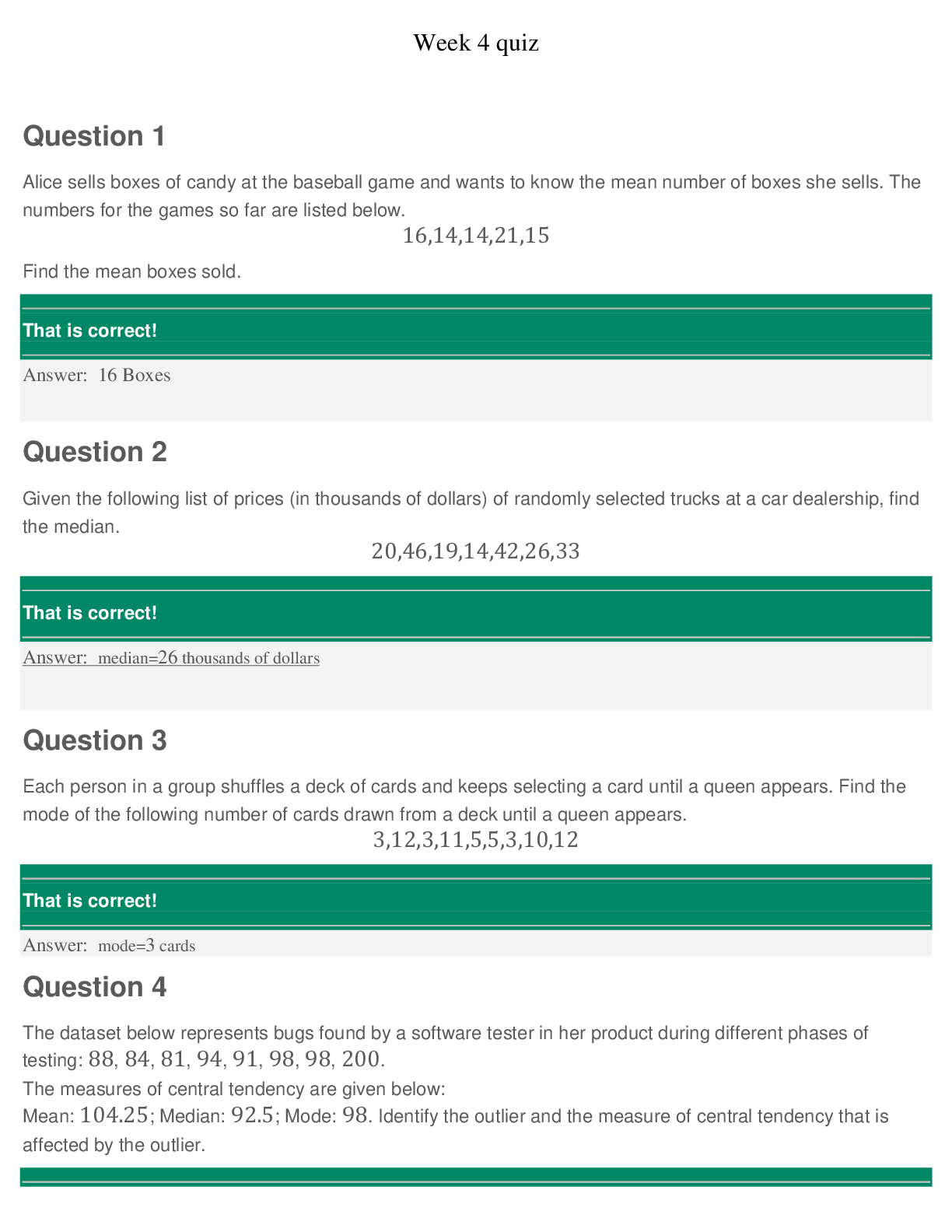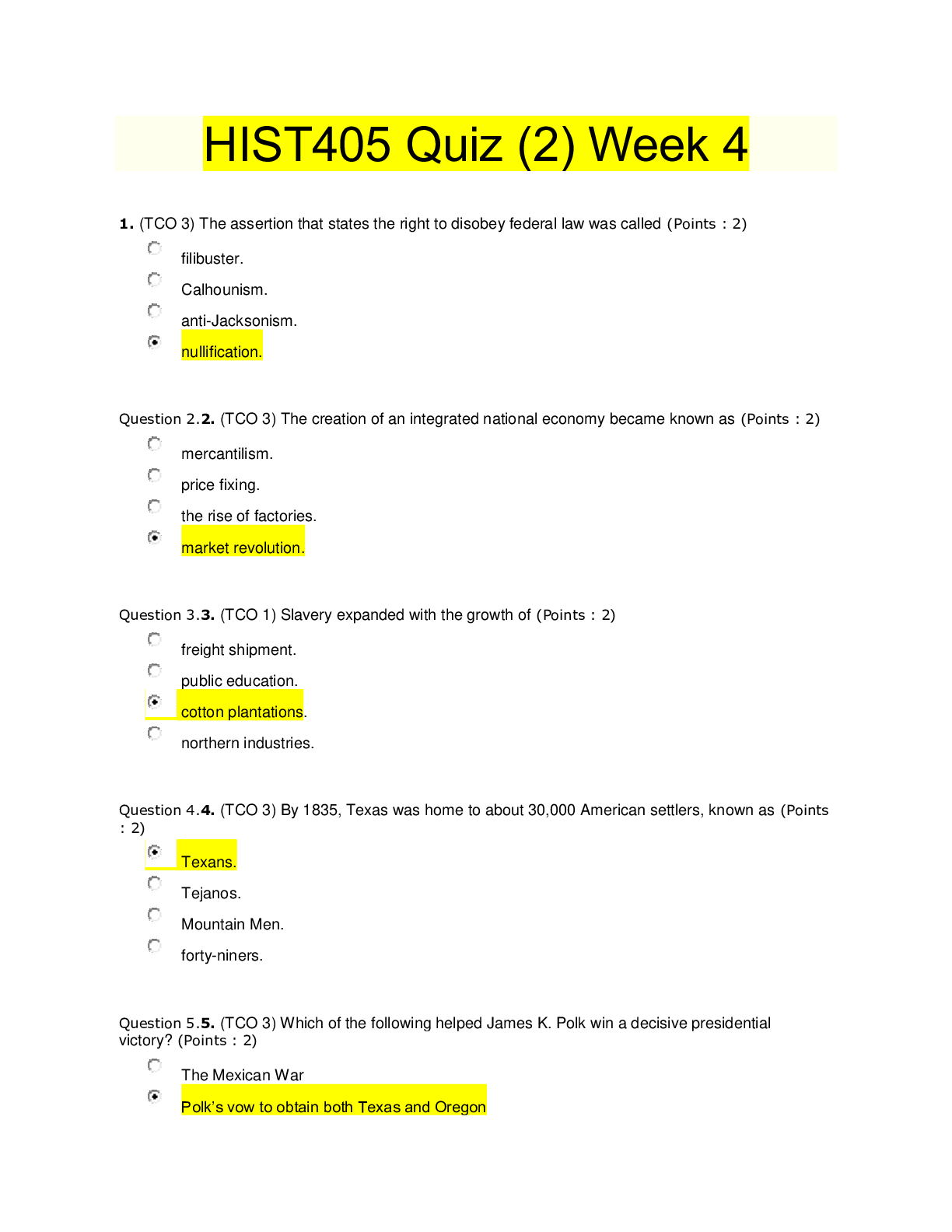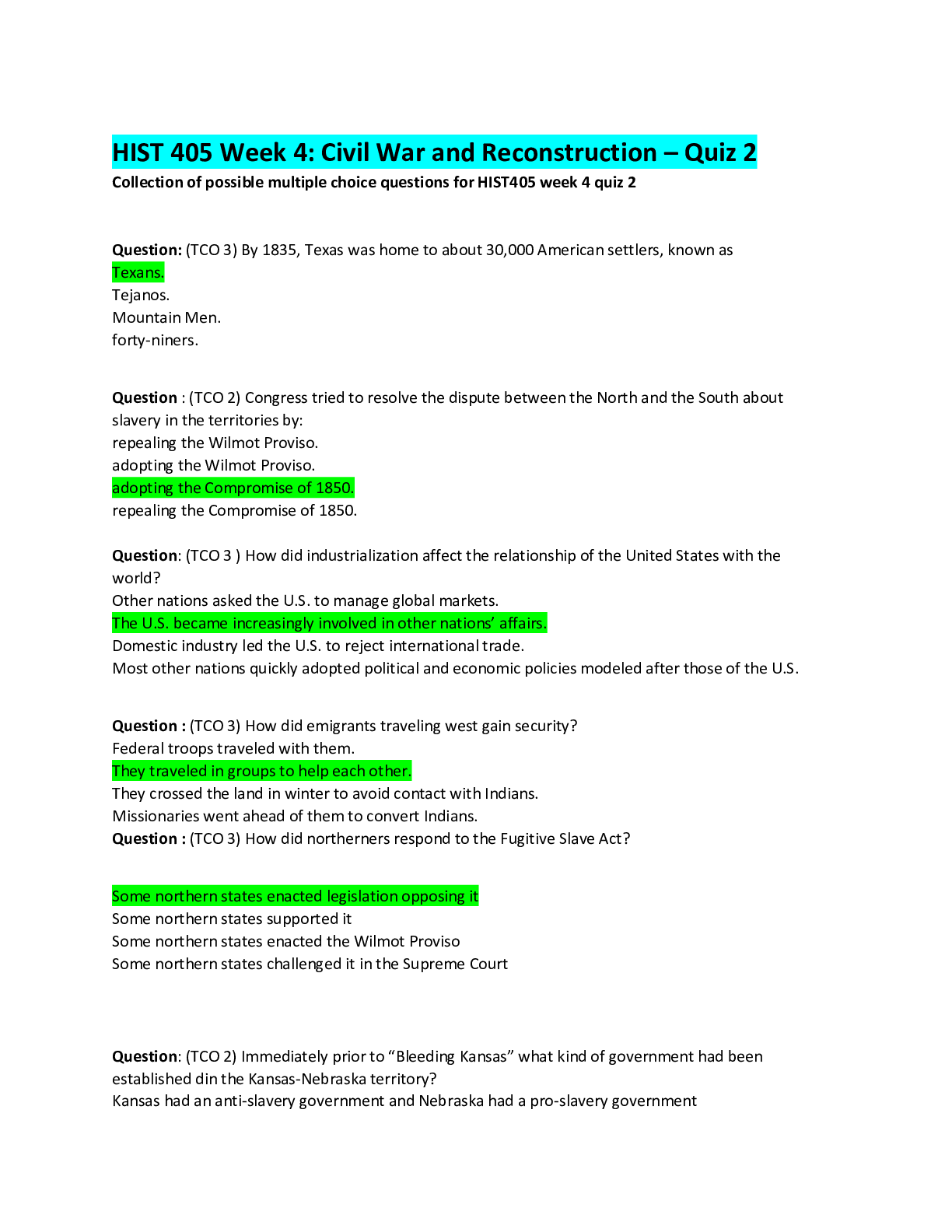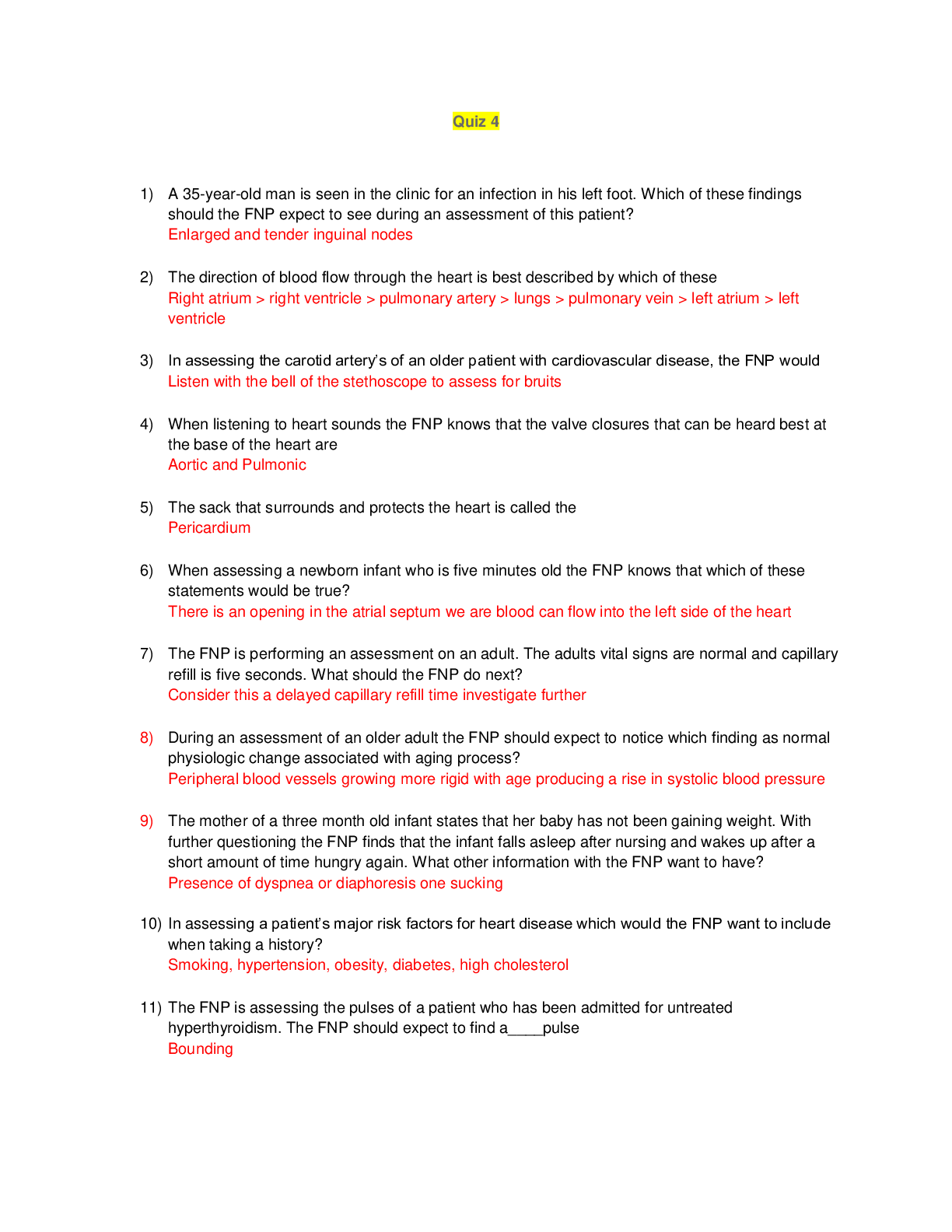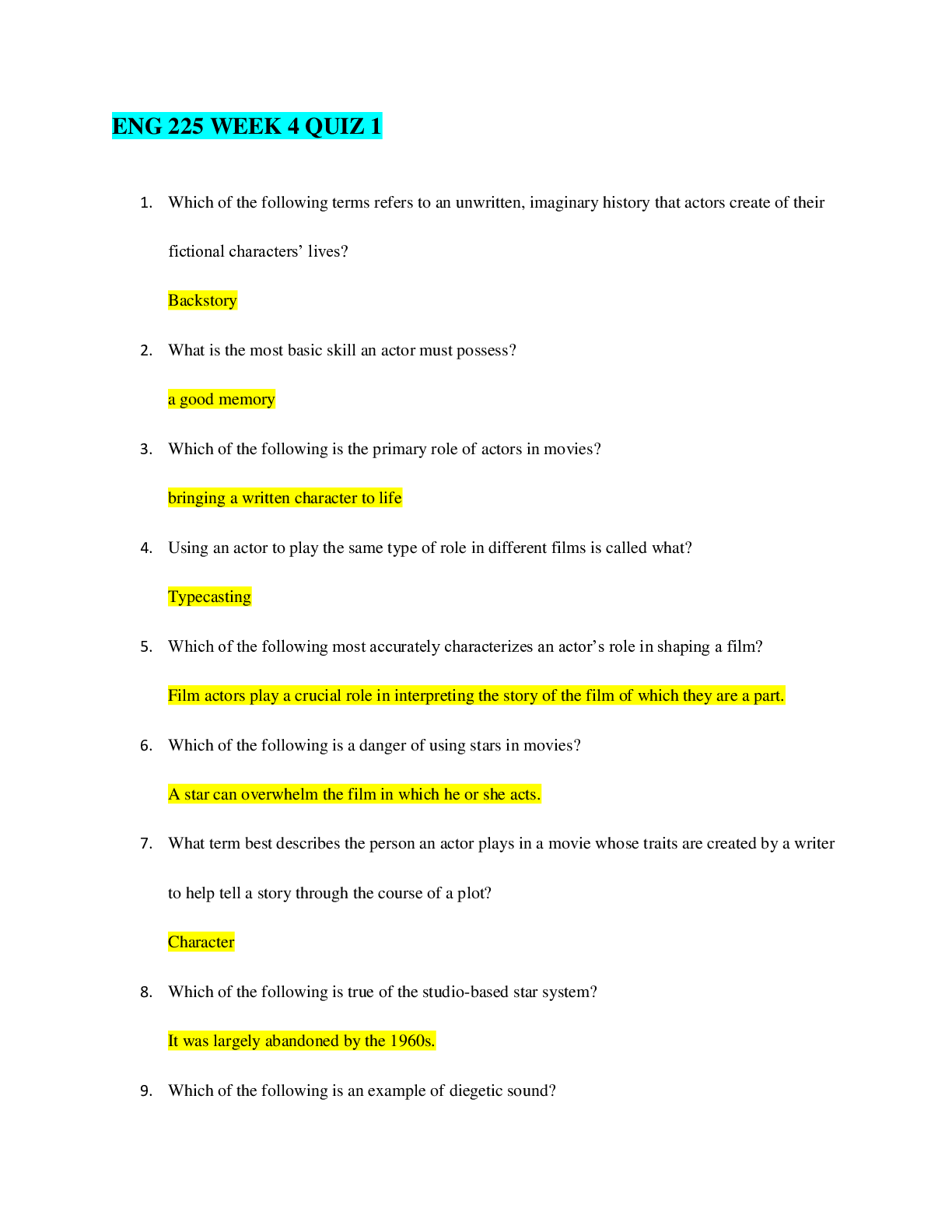*NURSING > EXAM > NURS 6512 Week 4 Quiz latest – Walden University | NURS6512 Week 4 Quiz latest (All)
NURS 6512 Week 4 Quiz latest – Walden University | NURS6512 Week 4 Quiz latest
Document Content and Description Below
NURS 6512 Week 4 Quiz latest – Walden University Adhesive skin glues are indicated for closure of which of the following wounds? Laceration to the chin Laceration to the chi... n • Question 2 2 out of 2 points The rationale for suturing wounds includes: All of the above All of the above • Question 3 2 out of 2 points Sally comes to your family practice clinic 24 hours after she lacerated her foot on an oyster shell. The wound is 4cm in length, shallow, and is on the sole of her foot. There is a small amount of bleeding on the dressing. She asks you to suture it closed because it keeps leaking blood. What is the best response? Inquire about her last tetanus immunization, cleanse the wounds, and tell Sally you cannot suture this wound because it has been open for more than 12 hours and because the risk for infection outweighs the benefit. Tell her you can apply steri strips but cannot close the wound tightly. Inquire about her last tetanus immunization, cleanse the wounds, and tell Sally you cannot suture this wound because it has been open for more than 12 hours and because the risk for infection outweighs the benefit. Tell her you can apply steri strips but cannot close the wound tightly. • Question 4 2 out of 2 points The characteristic that best differentiates psoriasis from other skin abnormalities is the: A. color of the scales. A. color of the scales. Response Feedback: Unlike other skin conditions, silvery papules and plaques characterize psoriasis. • Question 5 2 out of 2 points You have just completed a skin assessment on Mr. Baker. During your assessment, you have transilluminated a skin lesion. During the physical examination, you know that skin lesions are transilluminated to distinguish: C. fluid-filled from solid cysts or masses. C. fluid-filled from solid cysts or masses. Response Feedback: Transillumination is used to determine the presence of fluid in cysts and masses. Fluid-filled lesions will transilluminate with a red glow, and solid masses will not transilluminate. • Question 6 0 out of 2 points Which nail change found on examination would be most alarming? B. Yellow discoloration of the great toe of an older adult C. Single dark band in a white adult Response Feedback: Dark bands in a dark-skinned person are normal; yellow in the toe of an older adult can represent a nail disease or a chronic respiratory condition; pits are related to psoriasis. A single dark band in a white adult indicates a more serious condition—melanoma. • Question 7 0 out of 2 points Sweat glands, hair, and nails are all formed from: B. closely packed squamous cells. C. invaginations of epidermis into dermis. Response Feedback: Skin appendages are formed embryonically when the epidermis invaginates into the dermis. • Question 8 2 out of 2 points Transient mottling of the patient's skin in a cool room is a common finding in: B. newborn infants. B. newborn infants. Response Feedback: Cutis marmorata, a mottled appearance, is part of the newborn's response to changes in temperature. • Question 9 0 out of 2 points Cherry angiomas are a common finding in: C. pregnant women. A. adults older than 30 years. Response Feedback: Cherry angiomas occur in virtually everyone older than 30 years and increase numerically with age. • Question 10 2 out of 2 points Mrs. Leonard brings her newborn infant into the pediatrician's office for a first well-baby visit. As the health care provider, you teach her that newborns are more vulnerable to hypothermia due to: D. a poorly developed subcutaneous fat layer. D. a poorly developed subcutaneous fat layer. Response Feedback: Newborns have a poorly developed subcutaneous fat layer and so have a reduced ability to generate heat. • Question 11 2 out of 2 points Unusual white areas on the skin may be due to: C. vitiligo. C. vitiligo. Response Feedback: The absence of melanin produces unpigmented white areas known as vitiligo. • Question 12 2 out of 2 points The nurse inspects an annular lesion. What type of additional lighting source should be used for further assessment? B. Wood’s lamp B. Wood’s lamp Response Feedback: Annular lesions are characteristic of tinea, which are fluorescing lesions that illuminate as yellow-green under a Wood's lamp. • Question 13 2 out of 2 points Which of the following is an "ABCD" characteristic of malignant melanoma? A. Asymmetric borders A. Asymmetric borders Response Feedback: ABCD melanoma mnemonic includes asymmetry, borders that are irregular, color that is not the same all over, and diameter greater than 6 mm and growing. • Question 14 2 out of 2 points Café au lait patches are numbered with each assessment of infants and young children because: C. the presence of more than five patches suggests neurofibromatosis. C. the presence of more than five patches suggests neurofibromatosis. Response Feedback: The presence of more than five patches with diameters of greater than 1 cm in children younger than 5 years of age suggests neurofibromatosis. Fewer than five patches is usually considered harmless. Numbers of café au lait patches are not expected to increase each year. Coalescent lesions are not a more serious finding. Decreasing numbers are not expected with growth. • Question 15 2 out of 2 points Age spots are also called: B. senile lentigines. B. senile lentigines. Response Feedback: Senile lentigines are irregular, round, gray-brown lesions with a rough surface that occur in sun-exposed areas and are referred to as age spots. • Question 16 2 out of 2 points Mrs. Mulligan brings her 16-year-old son into the office for a sports physical examination. As the health care provider, you explain that normal hormone-related changes of adolescence include: A. increased oil production. A. increased oil production. Response Feedback: During adolescence, the sebaceous glands increase sebum production, which causes the skin to have an oily appearance and predisposes the individual to acne. • Question 17 2 out of 2 points The most common inflammatory skin condition is: B. eczematous dermatitis. B. eczematous dermatitis. Response Feedback: The most common inflammatory skin disorder is eczematous dermatitis. • Question 18 2 out of 2 points Expected hair distribution changes in older adults include: C. increased terminal hair follicles to the tragus of men’s ears. C. increased terminal hair follicles to the tragus of men’s ears. Response Feedback: The transition from vellus to terminal hair pattern occurs in older men at the nares and the tragus. • Question 19 2 out of 2 points A 5-year-old child presents with discrete vesicles on an erythematous base (dew drops on a rose petal appearance) that began near her scalp and are spreading to the trunk. The child has a low-grade fever and feels tired. What is the nurse's next action? A. Teach infectious control measures. A. Teach infectious control measures. Response Feedback: The description of this child's complaint is a varicella rash, not physical abuse or rubeola. Chickenpox is a highly communicable disease and can be prevented by immunization. The period of communicability lasts from 1 or 2 days before onset of the rash until all the vesicles have crusted over, which usually takes about a week. This is not physical abuse. Inspect the buccal mucosa for Koplik spots will not diagnose the problem. This will not resolve within a couple of days. • Question 20 2 out of 2 points Assessment of poor hygiene, healed fractures with deformity, or unexplained trauma in older adults indicates: B. physical neglect. B. physical neglect. Response Feedback: Described is the most common form of elder abuse: physical neglect. [Show More]
Last updated: 1 year ago
Preview 1 out of 11 pages

Buy this document to get the full access instantly
Instant Download Access after purchase
Add to cartInstant download
We Accept:

Reviews( 0 )
$12.50
Document information
Connected school, study & course
About the document
Uploaded On
Nov 14, 2020
Number of pages
11
Written in
Additional information
This document has been written for:
Uploaded
Nov 14, 2020
Downloads
0
Views
50














